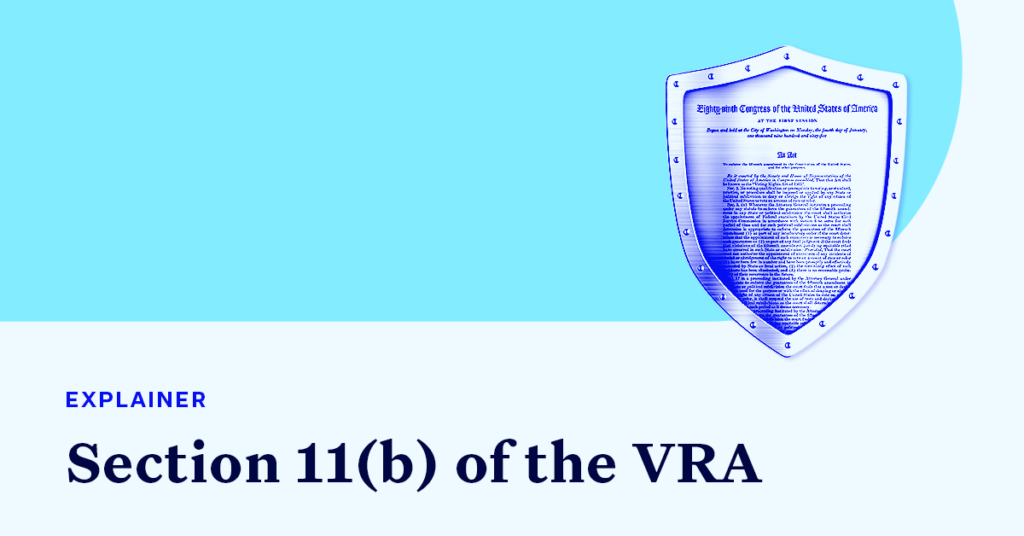Section 11(b) of the VRA Protects Voters From Intimidation

In the 2013 case Shelby County v. Holder, the U.S. Supreme Court dismantled Sections 4 and 5 of the Voting Rights Act of 1965 (VRA), the preclearance requirements often conceptualized as the heart of the VRA. Currently, other crucial protections against discriminatory voting rules and redistricting maps are on the Court’s chopping block.
While it’s accurate to say that the Court has “gutted” the VRA, this fails to capture the important sections of the VRA still in full effect. Section 11(b) is one of those crucial protections — it safeguards against voter intimidation and remains shockingly relevant in 2023.
Why do we need legislation to protect against voter intimidation?
When Black men gained political rights through the post-Civil War 13th, 14th and 15th Amendments, there was active participation in politics by Black citizens, many of whom were formerly enslaved. One historian estimates that around 2,000 Black Americans were elected to public office at local, state and federal levels during Reconstruction. An illustrative example is in Louisiana, where five Black Louisianans were elected to statewide office during the Reconstruction period, but none in the 146 years since then.
In response to the growing political and economic power of Black men, Southern states adopted laws that were specifically tailored to disenfranchise Black voters — poll taxes, grandfather clauses, literacy tests, felony disenfranchisement and more. But no tool was more effective than the long reign of violence and terror. In response to a contested 1872 gubernatorial election in Louisiana, a white mob killed over 100 Black men.
Just a few years before the Louisiana massacre, President Ulysses Grant signed several enforcement acts into law, attempting to counteract the continuing disregard for the Reconstruction amendments. These are sometimes referred to as the Ku Klux Klan (KKK) Acts, aimed at punishing the violent white supremacist group for its resistance to Black political power. The KKK Act of 1871, which contains an important precursor to Section 11(b), is still used in litigation today. The KKK Act establishes the basis for an individual to bring legal action against any individuals or organizations conspiring “to prevent by force, intimidation, or threat, any citizen who is lawfully entitled to vote.” Nearly a century later, further protections were enshrined in Section 131(b) of the Civil Rights Act of 1957, but neither laws went far enough.
Despite these reforms, voter intimidation remained a fixture of the Jim Crow period throughout the majority of the 20th century, prompting Congress to pass Section 11(b).
What does Section 11(b) do?
Enacted in 1965, Section 11(b) of the VRA outlaws any act that is likely to intimidate voters: “No person, whether acting under color of law or otherwise, shall intimidate, threaten, or coerce, or attempt to intimidate, threaten, or coerce any person for voting or attempting to vote.” The provision extends the same protections to anyone “urging or aiding” another individual to vote.
The section has similar protections to its precursors — the 1871 KKK Act and 1957 Civil Rights Act — but it was specifically drafted to be broader, and consequently more enforceable, than Section 131(b) in the 1957 legislation. Additionally, unlike Section 131(b), Section 11(b) of the VRA does not require proving intent or racial motivation, making it a more useful legal tool.
There has been a resurgence of Section 11(b) claims in the past two years.
According to a 2015 NYU Law Review article, Section 11(b) was brought sparingly in litigation in the decades after the VRA’s enactment. In fact, from 1965 to 2010, there were only 13 recorded voter intimidation cases that brought Section 11(b) claims.
Notably, this list includes at least one case with wide-reaching implications. In advance of a close New Jersey gubernatorial election in 1981, a vigilante police group calling themselves the National Ballot Security Task Force spent time in predominantly Black and Latino neighborhoods. The task force was actually created by the Republican National Committee (RNC) and engaged in other suppressive tactics. The Democratic National Committee filed a Section 11(b) case, leading to a consent decree that governed the RNC’s behavior for the next 35 years. It remained in effect until December 2017.
Voter intimidation isn’t a relic of the past. Often under the pretext of preventing voter fraud, there has been a resurgence of voter intimidation in the 2020 and 2022 elections, leading to at least six Section 11(b) cases just in the past two years. Several of these cases are ongoing, meaning that outstanding decisions could inform the body of law around voter intimidation, and hopefully, deter future conduct.